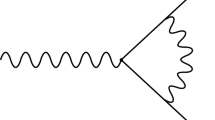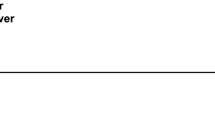Summary
We show that the ordinary perturbation expansion must, except in certain cases, be rearranged in order to uniquely carry out the infra-red exponentiation in a translation- and gauge-invariant way. The uniqueness of the exponent of order α follows from requiring exact order-by-order agreement with the OPE before summation and also from requiring that the exponentiation of all factorizable parts must be done before integration. By this rearrangement the remaining infra-red-regular part is defined in terms of correlations, with respect to photon momenta in the integrands. This automatically excludes an expontiation ambiguity of type exp[α(S)]→exp [α(S+C′)], which is possible if the exponentiation is performed after integration. We complete here the work on scalar electrodynamics initiated earlier by including radiative corrections, and also carry through the renormalization of this correlation rearrangement. All photons are treated identically. We believe that this makes our technique simpler and more advantageous than others.
Riassunto
Si mostra che lo sviluppo ordinario della perturbazione deve, tranne in alcuni casi, essere riordinato per effettuare l'esponenziazione dell'infrarosso in una maniera invariante di gauge e traslazione. L'unicità dell'esponente di ordine α segue dalla richiesta di un esatto accordo ordine per ordine con l'OPE prima della somma, e anche richiedendo che l'esponenziazione di tutte le parti fattorizzabili debba essere effettuato prima dell'integrazione. Per mezzo di questo riordinamento, la restante parte regolare nell'infrarosso è definita in termini di correlazioni rispetto agli impulsi dei fotoni negli integrandi. Questo fatto esclude automaticamente un'ambiguità di esponenziazione del tipo exp [a(S)]→exp[α[S+C′)], che è possibile se l'esponenziazione è effettuata dopo l'integrazione. Si completa in questo articolo il lavoro sull'elettrodinamica scalare, iniziato precedentemente, comprendendo correzioni radiative, ed inoltre si porta a termine la renormalizzazione di questo riordinamento della correlazione. Tutti i fotoni sono trattati allo stesso modo. Si ritiene che questo fatto renda la nostra tecnica più semplice e più vantaggiosa di altre.
Резюме
Мы показываем, что обычное пертурбационное разложение, за исключением некоторых случаев, должно быть перегруппировано для того, чтобы однозначно произвести выделение инфракрасной зкспоненты трансляционнои калибровочно-инвариантным образом. Единственность экспоненты порядка α следует из требования точного согласия в каждом порядке с обычным пертурбанционным разложением перед суммированием, а также из требования, чтобы выделение экспоненты для всех факторизуемых частей было бы проведено перед интегрированием. В результате этой перегруппировки остающиеся инфракрасные регулярные части определяются через корреляции импулясов фотоно в подынтегральных выражениях. Эта процедура автоматически исключает неоднозначность выделения экспоненты типа exp[α(S)]→exp[α(S+C′)], которая оказывается возможной, если выделение экспоненты производится после интегрирования. В этой работе мы рассматриваем спучай скалярной электродинамики, а также проводим перенормировку этой корреляционной перегруппировки. Все фотоны считаются тождественными. Отмечается, что наша техника является проще и обладает преимуществами по сравнению с другими подходами.
Similar content being viewed by others
References
L. Matsson:Phys. Rev. D,10, 2027 (1974).
K. E. Eriksson:Nuovo Cimento,19, 1010 (1961).
D. R. Yennie, S. C. Frautschi andH. Suura:Ann. of Phys.,13, 379 (1961).
G. Grammer andD. R. Yennie:Phys. Rev. D,8, 4332 (1973).
R. Barbieri, J. A. Mignaco andE. Remiddi:Nuovo, Cimento,11, 824 (1972).
F. E. Low:Phys. Rev.,110, 947 (1958).
L. Matsson:Phys. Rev. D,9, 2894 (1974).
H. Cheng andT. T. Wu:Phys. Rev.,186, 1611 (1969).
M. Levy andJ. Sucher:Phys. Rev.,186, 1656 (1969). A refined version of this model results if squares of photon momenta are retained:Phys. Rev. D,2, 1716 (1970).
This procedure has been carried through in detail for the scalar:ϕ 2:φ model:L. Matsson:Nucl. Phys.,95 B, 434 (1975).
J. D. Bjorken andS. D. Drell:Relativistic Quantum Mechanics (New York, N. Y., 1964), p. 175.
L. I. Schiff:Phys. Rev.,103, 443 (1956).
M. M. Islam:Nuovo Cimento,5 A, 315 (1971).
J. L. Cardy:Nucl. Phys.,33 B, 139 (1971).
I. G. Halliday, J. Huskins andC. T. Sachrajda:Nucl. Phys. 83 D, 189 (1974).
M. Ademollo, A. D'Adda, R. D'Auria, F. Gliozzi, E. Napolitano, S. Sciuto andP. Di Vecchia:Nucl. Phys.,94 B, 221 (1975).
S. Coleman andE. Weinberg:Phys. Rev. D,7, 1888 (1973).
W. Fischler, E. Gunzig andR. Brout:Nuovo Cimento,29 A, 504 (1975). See also ref. (13)L. I. Schiff:Phys. Rev.,103, 443 (1956).
L. Matsson: CERN preprint TH. 2177 (1976).
E. S. Fradkin: Doctoral dissertation (Moscow, 1960), Vol.29 ofThe Lebedev Physics Institute Series.
C. P. Korthals Altes andE. de Rafael:Nucl. Phys.,106 B, 237 (1976).
Author information
Authors and Affiliations
Additional information
Traduzione a cura della Redazione.
Переведено редакцией.
Rights and permissions
About this article
Cite this article
Matsson, L. Infra-red divergence enforces a rearranged perturbation expansion. Nuov Cim A 39, 604–630 (1977). https://doi.org/10.1007/BF02771034
Received:
Published:
Issue Date:
DOI: https://doi.org/10.1007/BF02771034




